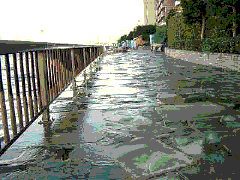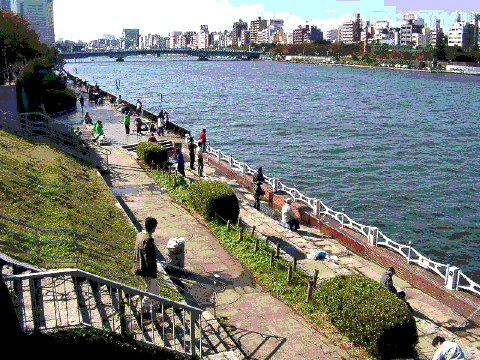

2003NSIII 「自然の化学的基礎」 課題 I
「川と人間生活」 隅田川(東京都)The Sumida River
松場菜摘
Coming back to Japan in the year 1997, I had only lived by the Sumida River at Tokyo for about 8 months before my family and I moved into a new house, where I live now. Yet even during this short period of 8 months, the Sumida River had influenced me to a great extent with its beauty and elegance, giving pleasure to those living and passing by the river including myself. With a deep history, the Sumida River is respected by the people of Tokyo and tourists visit endlessly to this River by walk, and most popularly, the メYakata Buneモ.
The Sumida River that flows now has many faces as it is running through seven wards through the city of Tokyo, but the Sumida River that I know of can be describe simply by the word メrelaxingモ. The River is approximately 150m in width on average and about 23.5 km in length, with fences around it separating its water from land. The water is not clear, yet not so polluted-looking either and the water has a shade of blue tint to it. It unfortunately is extremely man-made looking with the concrete walls beneath the fences and its separation from land. The land and water is not parallel to each other with us looking down at the water bed, which adversely put great distance between the viewers and the river. There are many bridges running over the river, buildings and skyscrapers surrounding the banks of the river, including the apartment that I had spent 8 months in. But the most significant of the Sumida River are the boats that float and tour around. Fishing boats can be seen often, but most common are the Yakata Bune, the tour boats and it is a symbolic part to the river. At night, the panorama is even more beautiful. There are lights lit up from the boats, bridges and the buildings around the bridge that reflect on the surface of the water, giving it a glow. I particularly enjoyed the view at night as it is more quiet and relaxed around the river.
During my 8 months stay at Tsukishima, I was fortunate to have the river in view from my window. Opening the window brought in a cool breeze and the smell of the river. I often went to the bank of the river to take a walk and to observe the river at a closer distance, to embrace the whole scenery. However, due to my busy schedule and being in middle school, I did not have ample time to enjoy the river as much as I would like to now. Yet I remember that at difficult times, I would go down to the river to think as it loosened up my tensed thoughts and calmed me down. Just looking at the river gave me inner peace and one time, I went down to the river to play the saxophone as well.
With me and my familyユs short history living by the river, my parents were unable to give me much information about the river 20-30 years ago, yet from what I have heard while living there, I have come to learn that the river had been cleansed many times, before it had turned out to what it is now. There are fishes living in the river now, but 20-30 years ago the water was too polluted for living animals. The river had been cleaned because of the recent developments around it; the apartments being built around. I had always thought that industrialization and developments brought about pollution, yet in this case, further development evoked out good to the environment. This example show the peopleユs love toward the Sumida River and how important the river had become over the few years.
There are ample web-sites that illustrate the Sumida River, and out of them, over 60% advertise the Yakata Boat tours. This tour attracts tourists to the river and gives a symbolic meaning to the cities that have the Sumida River flowing through it. The name Sumida-River was named in the year 1910 after a great flood and it is often noted that the Sumida River was in the past, connected to the Arakawa before the opening to a new river, the now Sumida River due to the great flood. In the Edo-Period, there were five great bridges that ran over where now stands the Sumida River, and they still exist after many reconstructions and fixings, and over 30 more new bridges had been built since then. The Sumida River flows and connects to the Tokyo Bay where the famous Rainbow Bridge tower across it. There are many festivals and events around the river every year, including the fire works festival over the summer and the spring festival where people celebrate the beauty of cherry blossoms. There are smaller events within certain neighborhoods such as the Fishing competition held couple of times a year. These events gather people together to the river and gives awareness and appreciation to the existence of the river. Recently, a swim-play area was built for children to enjoy the water from the river over the summer. It is not large, yet this playground shows how hard the people worked to make it possible for people to come in direct contact with the water.


I believe that the Sumida River and other rivers that exist today hold important significance to the people living by it. Although we do not use the river for water supply directly for laundry and bathing like the old times, the river still gives us direct pleasure and reminds us everyday the appreciation of beauty of nature. I hope that the Sumida River continues to exist with its purity that was achieved by the works of human hands, as it is almost impossible to get it back to its natural form, and that there are to be more swimming areas for children to play in to pass on the value of nature.
